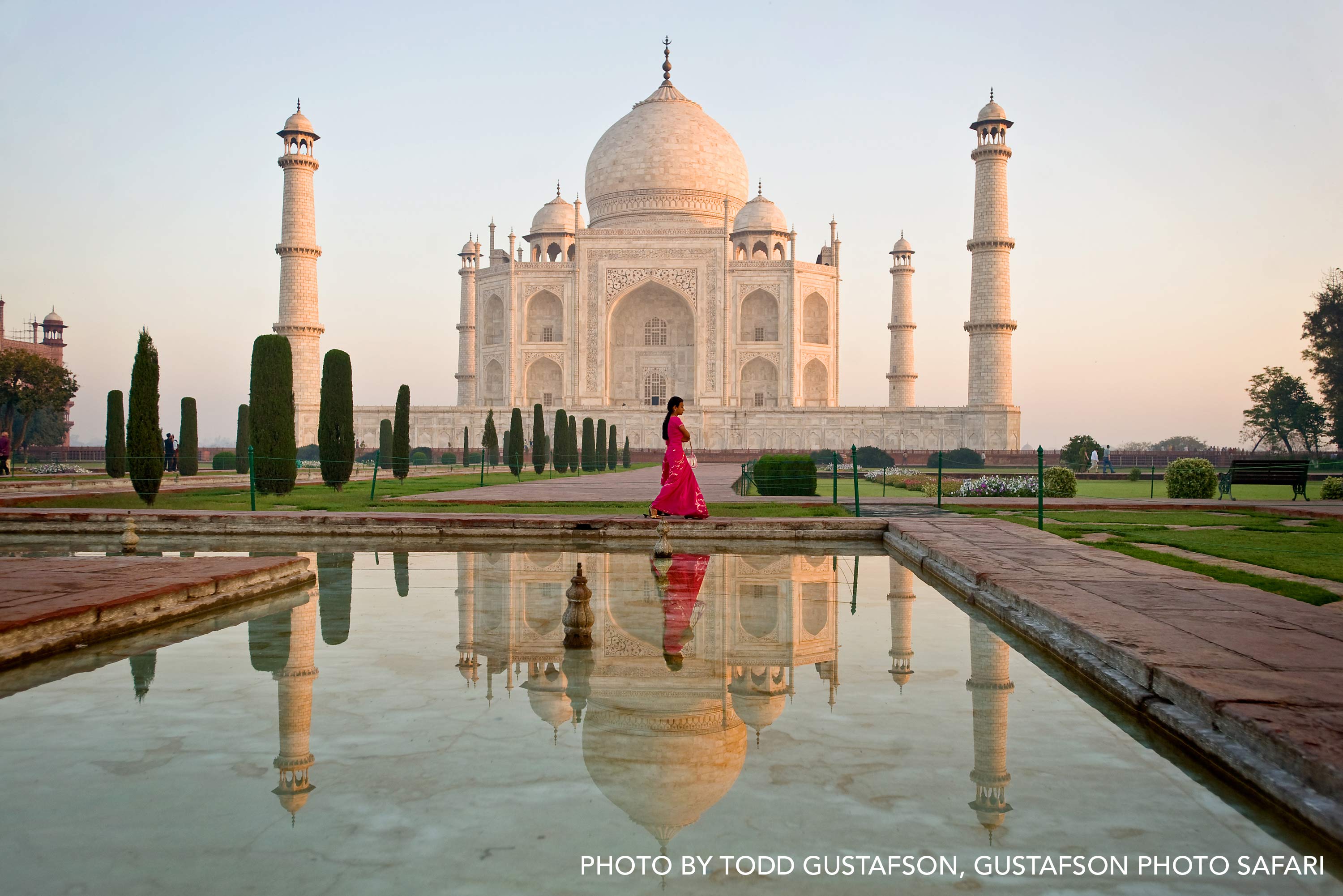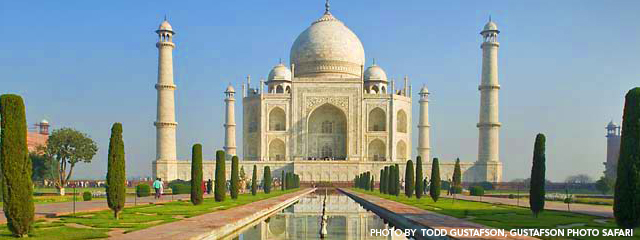 While the Taj Mahal is one of the most recognizable structures in the world, often its purpose goes unrecognized. Behind the creation of the marble mausoleum is a royal love story about an emperor whose unending love for his wife inspired him to create one of the world's most beautiful structures.
The love story begins when Mughal Emperor Shah Jahan was betrothed to Mumtaz Mahal, born Arjumand Banu Begum, in 1607 AD when he was just 15 years old and Mumtaz was 14. They wed five years later, and the couple was inseparable ever since.
Despite eventually having four other wives, Shah Jahan was only ever truly affectionate with Mumtaz. He felt she was one of the most beautiful women of their time, both in appearance and character, and as a result gave her the title Mumtaz Mahal, or "Chosen One of the Palace". She accompanied him wherever he traveled in the Mughal Empire, acting as a trusted companion. He was a dutiful husband to his first two wives, bearing one child with each. However, his deep love and attraction for Mumtaz was evident, as they had thirteen children together.
In 1631 AD, Mumtaz Mahal died giving birth to their fourteenth child. In the immediate time after her passing, Shah Jahan was consumed in grief and inconsolable. It has been reported that he mourned her death by secluding himself away from others for a year.
After coming out of mourning, Shah Jahan began the construction of the Taj Mahal at Agra in 1632 as a proper burial site for the love of his life, a process that would take 22 years. When it was completed in 1648, the Emperor described the Taj Mahal as follows:
Should guilty seek asylum here,
Like one pardoned, he becomes free from sin.
Should a sinner make his way to this mansion,
All his past sins are to be washed away.
The sight of this mansion creates sorrowing sighs;
And the sun and the moon shed tears from their eyes.
In this world this edifice has been made;
To display thereby the creator's glory.
18 years later, in January of 1666, Shah Jahan fell ill with dysentery. He became progressively weaker and soon after died under the care of his eldest daughter, Princess Jahanara Begum Sahib. The Princess planned a state funeral where the citizens of Agra came together to mourn the death of one of the greatest Moghul emperors. Even after all those years, there was only one place Shah Jahan would be laid to rest: next to the body of his beloved Mumtaz Mahal.
While the Taj Mahal is one of the most recognizable structures in the world, often its purpose goes unrecognized. Behind the creation of the marble mausoleum is a royal love story about an emperor whose unending love for his wife inspired him to create one of the world's most beautiful structures.
The love story begins when Mughal Emperor Shah Jahan was betrothed to Mumtaz Mahal, born Arjumand Banu Begum, in 1607 AD when he was just 15 years old and Mumtaz was 14. They wed five years later, and the couple was inseparable ever since.
Despite eventually having four other wives, Shah Jahan was only ever truly affectionate with Mumtaz. He felt she was one of the most beautiful women of their time, both in appearance and character, and as a result gave her the title Mumtaz Mahal, or "Chosen One of the Palace". She accompanied him wherever he traveled in the Mughal Empire, acting as a trusted companion. He was a dutiful husband to his first two wives, bearing one child with each. However, his deep love and attraction for Mumtaz was evident, as they had thirteen children together.
In 1631 AD, Mumtaz Mahal died giving birth to their fourteenth child. In the immediate time after her passing, Shah Jahan was consumed in grief and inconsolable. It has been reported that he mourned her death by secluding himself away from others for a year.
After coming out of mourning, Shah Jahan began the construction of the Taj Mahal at Agra in 1632 as a proper burial site for the love of his life, a process that would take 22 years. When it was completed in 1648, the Emperor described the Taj Mahal as follows:
Should guilty seek asylum here,
Like one pardoned, he becomes free from sin.
Should a sinner make his way to this mansion,
All his past sins are to be washed away.
The sight of this mansion creates sorrowing sighs;
And the sun and the moon shed tears from their eyes.
In this world this edifice has been made;
To display thereby the creator's glory.
18 years later, in January of 1666, Shah Jahan fell ill with dysentery. He became progressively weaker and soon after died under the care of his eldest daughter, Princess Jahanara Begum Sahib. The Princess planned a state funeral where the citizens of Agra came together to mourn the death of one of the greatest Moghul emperors. Even after all those years, there was only one place Shah Jahan would be laid to rest: next to the body of his beloved Mumtaz Mahal. While the Taj Mahal is one of the most recognizable structures in the world, often its purpose goes unrecognized. Behind the creation of the marble mausoleum is a royal love story about an emperor whose unending love for his wife inspired him to create one of the world's most beautiful structures.
The love story begins when Mughal Emperor Shah Jahan was betrothed to Mumtaz Mahal, born Arjumand Banu Begum, in 1607 AD when he was just 15 years old and Mumtaz was 14. They wed five years later, and the couple was inseparable ever since.
Despite eventually having four other wives, Shah Jahan was only ever truly affectionate with Mumtaz. He felt she was one of the most beautiful women of their time, both in appearance and character, and as a result gave her the title Mumtaz Mahal, or "Chosen One of the Palace". She accompanied him wherever he traveled in the Mughal Empire, acting as a trusted companion. He was a dutiful husband to his first two wives, bearing one child with each. However, his deep love and attraction for Mumtaz was evident, as they had thirteen children together.
In 1631 AD, Mumtaz Mahal died giving birth to their fourteenth child. In the immediate time after her passing, Shah Jahan was consumed in grief and inconsolable. It has been reported that he mourned her death by secluding himself away from others for a year.
After coming out of mourning, Shah Jahan began the construction of the Taj Mahal at Agra in 1632 as a proper burial site for the love of his life, a process that would take 22 years. When it was completed in 1648, the Emperor described the Taj Mahal as follows:
Should guilty seek asylum here,
Like one pardoned, he becomes free from sin.
Should a sinner make his way to this mansion,
All his past sins are to be washed away.
The sight of this mansion creates sorrowing sighs;
And the sun and the moon shed tears from their eyes.
In this world this edifice has been made;
To display thereby the creator's glory.
18 years later, in January of 1666, Shah Jahan fell ill with dysentery. He became progressively weaker and soon after died under the care of his eldest daughter, Princess Jahanara Begum Sahib. The Princess planned a state funeral where the citizens of Agra came together to mourn the death of one of the greatest Moghul emperors. Even after all those years, there was only one place Shah Jahan would be laid to rest: next to the body of his beloved Mumtaz Mahal.
While the Taj Mahal is one of the most recognizable structures in the world, often its purpose goes unrecognized. Behind the creation of the marble mausoleum is a royal love story about an emperor whose unending love for his wife inspired him to create one of the world's most beautiful structures.
The love story begins when Mughal Emperor Shah Jahan was betrothed to Mumtaz Mahal, born Arjumand Banu Begum, in 1607 AD when he was just 15 years old and Mumtaz was 14. They wed five years later, and the couple was inseparable ever since.
Despite eventually having four other wives, Shah Jahan was only ever truly affectionate with Mumtaz. He felt she was one of the most beautiful women of their time, both in appearance and character, and as a result gave her the title Mumtaz Mahal, or "Chosen One of the Palace". She accompanied him wherever he traveled in the Mughal Empire, acting as a trusted companion. He was a dutiful husband to his first two wives, bearing one child with each. However, his deep love and attraction for Mumtaz was evident, as they had thirteen children together.
In 1631 AD, Mumtaz Mahal died giving birth to their fourteenth child. In the immediate time after her passing, Shah Jahan was consumed in grief and inconsolable. It has been reported that he mourned her death by secluding himself away from others for a year.
After coming out of mourning, Shah Jahan began the construction of the Taj Mahal at Agra in 1632 as a proper burial site for the love of his life, a process that would take 22 years. When it was completed in 1648, the Emperor described the Taj Mahal as follows:
Should guilty seek asylum here,
Like one pardoned, he becomes free from sin.
Should a sinner make his way to this mansion,
All his past sins are to be washed away.
The sight of this mansion creates sorrowing sighs;
And the sun and the moon shed tears from their eyes.
In this world this edifice has been made;
To display thereby the creator's glory.
18 years later, in January of 1666, Shah Jahan fell ill with dysentery. He became progressively weaker and soon after died under the care of his eldest daughter, Princess Jahanara Begum Sahib. The Princess planned a state funeral where the citizens of Agra came together to mourn the death of one of the greatest Moghul emperors. Even after all those years, there was only one place Shah Jahan would be laid to rest: next to the body of his beloved Mumtaz Mahal.Up Next...
Learning, Connecting, and Birdwatching at the Belize Birding Festival
Guest post by Holbrook Ambassador Debbie JordanEarlier this month, I was honored to represent Holbrook as the keynote speaker at the fifth annual Belize Birding Festival. Way down in the southeast co
Photo of the Month: November 2025
Above: On the way to see baobab trees at sunset on the red dirt roads in the bush of Madagascar, we stopped as the young goat herders crossed directly in front of us, looking like majestic figures in the sunlit, dusty glow. It felt like the scene of a movie, and this photo captured the feeling of that moment perfectly.
eBird Trip Reports: South Africa
Want to know which species other Holbrook travelers have seen on their birding trips to South Africa? Check out these eBird trip reports shared by past groups to see their checklists and get an idea of what you might encounter on your own birding expedition.












